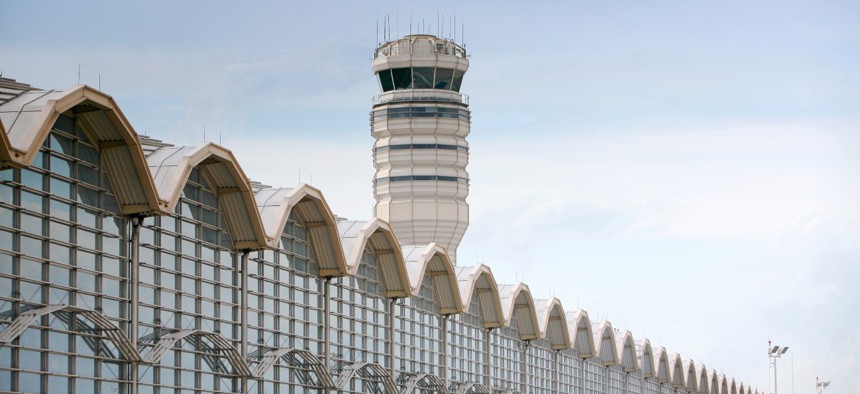
The control tower at Ronald Reagan National Airport. FAA is near or exceeding its staff capacity. Terraxplorer / Getty Images
The House, Senate and White House all want more FAA staffing, but disagree on how to get there
All parties acknowledge the agency is facing a crisis that will cause mass disruptions to air travel absent more resources.
The Federal Aviation Administration is in line for a surge of new staffing amid concerns the agency is reaching or exceeding the limits of its capacity, but there remain disagreements over how to deliver the resources.
There is bipartisan, bicameral agreement that FAA is in desperate need for more air traffic controllers and support personnel, which lawmakers and the White House are looking to address before the agency’s current authorization expires this fall. FAA warned earlier this year that staffing shortages would cause a spike in flight delays and force the agency to ask airlines in certain locations to operate fewer flights.
The House is scheduled to vote on its version of an FAA reauthorization bill this week, which previously won unanimous approval in a 63-0 vote before the Transportation and Infrastructure Committee. The measure would require FAA to set annual hiring targets through fiscal 2027 for air traffic controllers at the maximum level it can train through its academy. As FAA workforce unions have long requested, the agency would have to create and adopt a new workforce model that takes into consideration the needs of individual facilities and input from the labor groups.
“Our aviation system is experiencing a shortage of qualified workers, including pilots, mechanics and air traffic controllers,” transportation committee leaders said of the bill earlier this month. “This bill addresses workforce challenges by removing barriers to pursuing aviation careers, expanding the aviation workforce pipeline, improving training standards, and more.”
Congress will consider its FAA reauthorization bills on the heels of a Transportation Department inspector general report that found a lack of certified controllers created a risk to air traffic operations. The auditors criticized FAA for lacking a staffing plan and noted—as the agency did in testimony to Congress earlier this year—that many facilities were below the 85% staffing threshold that forces prioritized placement. A recent working group found FAA must maintain more than 14,000 controllers to meet demand, compared to the 12,000 the agency is targeting under its current model and the 10,600 it has on staff.
The White House on Monday took issue with the workforce provisions in the House bill, suggesting they would improperly undermine executive branch decision making. It also said the measure more broadly would institute organizational reforms that would undercut the agency administrator’s authorities.
“While the administration supports the goal of improving the efficiency of the organizational structure of the FAA, it does not support the proposed changes in FAA rulemaking review and the weakening of the administrator’s ability and authority to determine the appropriate size and allocation of the air traffic controller workforce,” the Office of Management and Budget said in a statement of administration policy.
The Senate Commerce, Science and Transportation Committee introduced its version of the FAA reauthorization legislation last month with bipartisan support from leaders of the panel, though it has yet to hold a vote on the measure. The bill would expand air traffic controller training capacity and also requires a new staffing model.
“The bipartisan FAA Reauthorization Act will help get the air travel system soaring again by improving safety and service,” said Sen. Maria Cantwell, D-Wash., who chairs the committee. “The bill provides funding for the latest safety technology on runways, and to hire more air traffic controllers, pilots and mechanics.”
The measure has hit a snag as lawmakers have disagreed on provisions including whether to expand long-distance flights out of Ronald Reagan National Airport outside Washington, D.C., and the number of training hours pilots must complete.
The National Air Traffic Controllers Association has endorsed both bills, saying they contain key workforce provisions the union has long demanded. Professional Aviation Safety Specialists, however, said the workforce changes in the House bill were not sufficiently comprehensive. The union, which represents safety inspectors and technicians at FAA, stated that it preferred the Senate version because it would audit the agency’s workforce plans, improve employees’ understanding of the technology they oversee and direct FAA to hire the appropriate number of support employees.
“I’m pleased the Senate’s bill took into account the concerns we have about staffing levels within the workforces we represent,” PASS President Dave Spero said. “The agency is expecting to do more for the National Airspace System with less. And that is not sustainable.”
Lawmakers have proposed hundreds of amendments to the House version of the bill, including those related to touchstone cultural issues. Assuming both chambers can pass their bills, they will seek to resolve differences through a conference committee before the Sept. 30 deadline.
Lawmakers are seeking to address the acute problem through the fiscal 2024 appropriations process. House Republicans’ funding bill for Transportation included a spending increase at FAA that would enable the agency to hire 1,800 new air traffic controllers, matching President Biden’s request. The fiscal 2023 omnibus spending bill provided funding for 1,500 new controllers.
“The hiring and training surge will streamline the path for controller training while further increasing resiliency to serve high demand markets as air traffic increases to pre-pandemic levels,” FAA said in its fiscal 2024 budget request.







